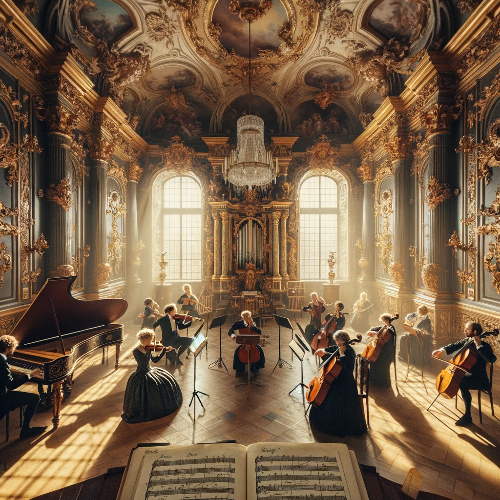Baroque music, which spanned from the end of the sixteenth century to the middle of the eighteenth century, is an artistic and musical movement that has profoundly marked the history of music. Characterized by its expressiveness, harmonic richness, and innovative use of instruments, Baroque music gave rise to many musical genres and forms that continue to influence musicians and composers to this day.
Origins and Context of Baroque Music The Baroque period, beginning around 1600 and ending around 1750, was a time of great transformation and innovation in the field of music. It coincides with the apogee of the Baroque movement in architecture, painting and literature. Baroque composers sought to express deep and complex emotions through compositions that fully exploit the possibilities of instruments and voices.
The Emblematic Composers of Baroque Music Among the most outstanding figures in Baroque music, Johann Sebastian Bach, Jean-Baptiste Lully and Jean-Philippe Rameau stand out for their exceptional contributions.
Johann Sebastian Bach : Considered one of the greatest composers of all time, Bach enriched the Baroque repertoire with works such as the "Well-Tempered Clavier" and the "Brandenburg Concertos". His mastery of the basso continuo and contrapuntal forms has influenced many generations of musicians.
Jean-Baptiste Lully : A composer at the court of Louis XIV, Lully played a crucial role in the development of lyric tragedy, a genre of French opera that combined music, dance and theatre. His works, such as the "Indes galantes", reflect the Baroque taste for grandeur and spectacle.
Jean-Philippe Rameau : Known for his operas and keyboard works, Rameau was a harmonic innovator. His compositions explored new sonic possibilities and contributed to the evolution from the Baroque style to classicism.
Baroque Musical Instruments Baroque music is rich in instrumental diversity. Ancient instruments, such as viola da gamba, harpsichords, and lutes, played a central role in Baroque compositions.
Viola da gamba : Used for both chamber music and large ensembles, violas da gamba offer a soft and expressive sound that is characteristic of the Baroque style.
Harpsichord : A key instrument of baroque music, the harpsichord is used for the basso continuo and solos. Its precise metallic tone is ideal for polyphonic rooms.
Lute : Popular in the 1970s for early music recordings, the lute was a versatile instrument for accompaniment and soloing, particularly in trio sonatas.
Baroque Musical Genres and Forms The Baroque is characterized by a wide variety of musical genres and forms, ranging from Italian operas to solo concertos.
Concerto grosso : This musical genre contrasts a small group of soloists with a larger orchestra. Composers like Arcangelo Corelli and Antonio Vivaldi excelled in this style.
Trio Sonata : Typical of Baroque chamber music, this musical form involves two melodic instruments accompanied by a basso continuo, often played by a harpsichord and a viola da gamba.
Italian operas : With composers like Claudio Monteverdi, opera became a major genre of the Baroque, combining music, drama and spectacle.

The Influence of Baroque Music The influence of Baroque music extended far beyond its time. From the nineteenth century until the twentieth century, composers and musicians rediscovered and reinterpreted Baroque works, ensuring their longevity. The 1970s saw a revival of interest in Baroque music, with historical recordings and performances on period instruments.
French Baroque Music France has been a major center of Baroque music, with composers like Marc-Antoine Charpentier and Jean-Baptiste Lully. Their work for the court of Louis XIV helped define the French Baroque style, characterized by a great attention to elegance and clarity.
Instrumental Baroque Music Baroque instrumental music, with works for harpsichord, violin and flute, explored new sonic possibilities. Domenico Scarlatti, with his keyboard sonatas, extended the technical and expressive limits of the instruments of his time.
Listen to Baroque Music Today Today, baroque music is easily accessible through platforms like YouTube, where you can listen to recordings of famous and lesser-known pieces. Musicians such as Gustav Leonhardt and Nikolaus Harnoncourt have played a crucial role in the rediscovery and dissemination of this repertoire.
Conclusion Baroque music, with its richness and diversity, continues to captivate and inspire. From Johann Sebastian Bach to Jean-Philippe Rameau, Baroque composers have created a musical legacy that remains alive and relevant. Their work reflects a period of great innovation and creativity, the influence of which is still felt today.
FAQs
What characterizes baroque music? Baroque music is distinguished by its expressiveness, its use of the basso continuo, and the diversity of its musical forms, such as the concerto grosso and the trio sonata.
Who are the emblematic composers of baroque music? Johann Sebastian Bach, Jean-Baptiste Lully and Jean-Philippe Rameau are among the most outstanding composers of this period.
What instruments were used in baroque music? Typical instruments include viola da gamba, harpsichord, and lute, as well as other string and wind instruments.
How did Baroque music influence the following eras? From the nineteenth century until the twentieth century, Baroque works were rediscovered and reinterpreted, influencing many composers and musicians.
Where can you listen to baroque music today? Baroque music is widely available on platforms like YouTube, with performances by genre specialists and historical recordings.
What are Johann Sebastian Bach's contributions to Baroque music? Johann Sebastian Bach enriched the Baroque repertoire with major works such as the "Well-Tempered Clavier" and the "Brandenburg Concertos", exploring new dimensions of polyphony and harmony.

